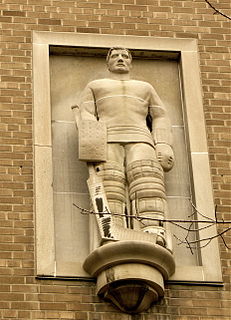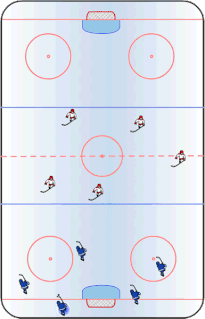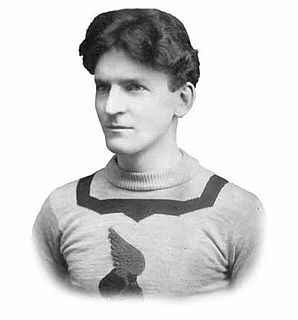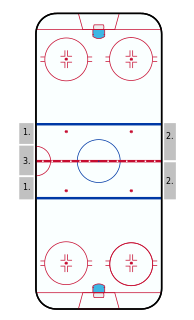This article needs additional citations for verification .(February 2014) (Learn how and when to remove this template message) |
The point is a term in ice hockey to indicate a position inside the opposition's blue line along the edges of the rink.
This article needs additional citations for verification .(February 2014) (Learn how and when to remove this template message) |
The point is a term in ice hockey to indicate a position inside the opposition's blue line along the edges of the rink.
A player in the opponent's end zone at the junction of the blue line with the boards is said to be at the point. Usually the players at the two points are the defencemen. On the power play the players playing at these positions are always known as the points, though one of the positions is sometimes played by a forward.
The point's responsibilities include attempting to keep the puck in the offensive zone when the defensive team attempts to clear (see also Offside (ice hockey)), receiving a pass from the forwards to allow the play to reset, and taking slapshots at the goal, hoping to score, create a rebound or a deflection. On the power play, one of the players playing the point is typically the "quarterback" - that is, the one who controls (through passing) where the puck goes, and also takes many shots.
Given the difficulty of scoring directly from the point due to the distance to the goal, goals scored from the point are typically either on screens, or are tipped goals.
In the early years of ice hockey, the two defencemen were known as the "point" and "cover-point" players. The term the point may have been derived from that early terminology. The point played further back, while the cover-point was allowed more latitude to roam forward. [1]

Ice hockey is a contact team sport played on ice, usually in an indoor or outdoor rink, in which two teams of skaters use their sticks to shoot a vulcanized rubber puck into their opponent's net to score goals. The sport is known to be fast-paced and physical, with teams usually fielding six players at a time: one goaltender to stop the puck from going into their own net, two defensemen, and three forwards who skate the span of the ice trying to control the puck and score goals against the opposing team.

In many team sports which involve scoring goals, the goalkeeper is a designated player charged with directly preventing the opposing team from scoring by blocking or intercepting opposing shots on goal that kicks the ball from the other player.

In ice hockey, a goal is scored when the puck entirely crosses the goal line between the two goal posts and below the goal crossbar. A goal awards one point to the team attacking the goal scored upon, regardless of which team the player who actually deflected the puck into the goal belongs to. Typically, a player on the team attempting to score shoots the puck with their stick towards the goal net opening, and a player on the opposing team called a goaltender tries to block the shot to prevent a goal from being scored against their team.

The centre in ice hockey is a forward position of a player whose primary zone of play is the middle of the ice, away from the sideboards. Centres have more flexibility in their positioning and are expected to cover more ice surface than any other player. Centres are ideally stronger, faster skaters who can back-check quickly from deep in the opposing zone. Generally, centres are expected to be gifted passers more than goal scorers, although there are exceptions, typically larger centres who position themselves directly in front of the net in order to score off rebounds. They are also expected to have exceptional "ice vision", intelligence, and creativity. They also generally are the most defensively-oriented forwards on the ice. Centres usually play as part of a line of players that are substituted frequently to keep fresh and keep the game moving.
In ice hockey, a forward is a player position on the ice whose primary responsibility is to score and assist goals. Generally, the forwards try to stay in three different lanes of the ice going from goal to goal. It is not mandatory, however, to stay in a lane. Staying in a lane aids in forming the common offensive strategy known as a triangle. One forward obtains the puck and then the forwards pass it between themselves making the goalie move side to side. This strategy opens up the net for scoring opportunities. This strategy allows for a constant flow of the play, attempting to maintain the control of play by one team in the offensive zone. The forwards can pass to the defence players playing at the blue line, thus freeing up the play and allowing either a shot from the point or a pass back to the offence. This then begins the triangle again.

Winger, in the game of ice hockey, is a forward position of a player whose primary zone of play on the ice is along the outer playing area. They typically work by flanking the centre forward. Originally the name was given to forward players who went up and down the sides of the rink. Nowadays, there are different types of wingers in the game — out-and-out goal scorers, checkers who disrupt the opponents, and forwards who work along the boards and in the corners. Often a winger's precise role on a line depends upon what type of role the other winger plays; usually lines will have one more goal-scoring oriented winger and one winger more focused on playing the boards, checking and passing the puck to others to take shots. They tend to be bigger than centreman and smaller than defenseman.

Defence in ice hockey is a player position whose primary responsibility is to prevent the opposing team from scoring. They are often referred to as defencemen, D, D-men or blueliners. They were once called cover-point.

In ice hockey, the goaltender or goalie is the player responsible for preventing the hockey puck from entering their team's net, thus preventing the opposing team from scoring. The goaltender usually plays in or near the area in front of the net called the goal crease. Goaltenders tend to stay at or beyond the top of the crease to cut down on the angle of shots. In today's age of goaltending there are two common styles, butterfly and hybrid. Because of the power of shots, the goaltender wears special equipment designed to protect the body from direct impact. The goalie is one of the most valuable players on the ice, as their performance can greatly change the outcome or score of the game. One-on-one situations, such as breakaways and shootouts, have the tendency to highlight a goaltender's pure skill, or lack thereof. No more than one goaltender is allowed to be on the ice for each team at any given time. Teams are not required to use a goaltender and may instead opt to play with an additional skater, but the defensive disadvantage this poses generally means that the strategy is only used as a desperation maneuver when trailing late in a game or can be used if the opposing team has a delayed penalty.

An ice hockey rink is an ice rink that is specifically designed for ice hockey, a competitive team sport. Alternatively it is used for other sports such as broomball, ringette and rink bandy. It is a rectangle with rounded corners and surrounded by walls approximately 1.22 metres (48 in) high called the boards.
In ice hockey, a penalty shot is a type of penalty awarded when a team loses a clear scoring opportunity on a breakaway because of a foul committed by an opposing player. A player from the non-offending team is given an attempt to score a goal without opposition from any defending players except the goaltender. This is the same type of shot used in a shootout to decide games in some leagues.

The neutral zone trap is a defensive strategy used in ice hockey to prevent an opposing team from proceeding through the neutral zone and to force turnovers. The strategy is generally used to level the playing field for teams that are not as offensively talented as their opponents, although the trap can also be used by teams simply looking to protect a lead late in the game. The trap was innovated by the Toronto Maple Leafs in the 1920s and 1930s but became the defensive scheme for most coaches during the late 90s and early 2000s—known as the "Dead Puck era"—as a direct result of the success seen by the New Jersey Devils under the coaching of Jacques Lemaire; the Devils won three Stanley Cup championships during this era. Lemaire utilized the trap that was employed by the Montreal Canadiens under his coach Scotty Bowman.
In ice hockey, point has three contemporary meanings.
The Amateur Hockey Association of Canada (AHAC) was an amateur men's ice hockey league founded on 8 December 1886, in existence until 1898. It was the second ice hockey league organized in Canada, after one in Kingston, Ontario started in 1883. It was organized to provide a longer season to determine the Canadian champion. Prior to its founding, the Canadian championship was determined in a tournament in Montreal. It is the first championship ice hockey league.
In ice hockey, a play is offside if a player on the attacking team does not control the puck and is in the offensive zone when a different attacking player causes the puck to enter the offensive zone, until either the puck or all attacking players leave the offensive zone. Simply put, the puck must not enter the attacking zone after attacking players. If a player on the attacking team is in the offensive zone before the puck, either an immediate offside occurs, or they must retreat to the neutral zone.

Roller inline hockey, or inline hockey is a variant of hockey played on a hard, smooth surface, with players using inline skates to move and hockey sticks to shoot a hard, plastic puck into their opponent's goal to score points. There are five players including the goalkeeper from each team on the rink at a time, while teams normally consist of 16 players.

Henry Judah "Flip" Trihey was a Canadian amateur ice hockey player and executive in the era before professional ice hockey. Trihey played the centre forward position for the Montreal Shamrocks from 1897 to 1901, and was regarded as the best forward of his day during his playing years.

The Miracle on Manchester is the nickname given to a National Hockey League (NHL) playoff game between the Los Angeles Kings and Edmonton Oilers that took place on April 10, 1982 in the league's 65th season. The game, the third in a best-of-five postseason series, was played at The Forum, the Kings' home arena at the time, which was situated on Manchester Boulevard in the Los Angeles suburb of Inglewood. The Kings completed the largest comeback in NHL playoff history, going from being down 5-0 to win the game 6-5 in overtime. Combined with upset wins in Games 1 and 5, the Kings eliminated the heavily favored Wayne Gretzky-led Oilers in a 3-2 series victory to reach the second round.

The National Hockey League rules are the rules governing the play of the National Hockey League (NHL), a professional ice hockey organization. Infractions of the rules, such as offside and icing, lead to a stoppage of play and subsequent to the offending teams. The league also determines the specifications for playing equipment used in its games.
This is a list of common terms used in ice hockey along with the definition of these terms.
The NHL All-Star Game SuperSkills Competition, originally known as the National Hockey League All-Star Skills Competition, is an event on the night preceding the All-Star Game. Started at the 41st National Hockey League All-Star Game in Pittsburgh in 1990, the NHL uses the event to showcase the talents of its all-star participants. Events include accuracy shooting, fastest skater, Skills Challenge Relay, hardest shot, Breakaway Challenge, and an Elimination Shootout. The All-Star teams select representatives for each event, with points awarded to the winning team.